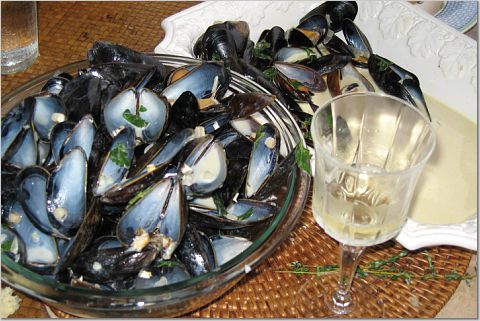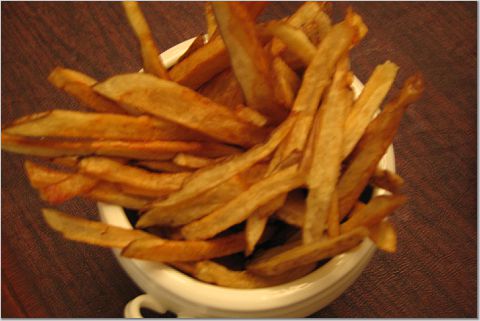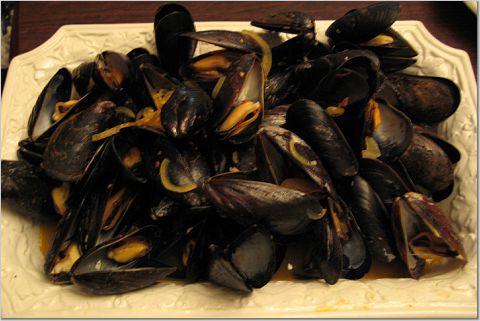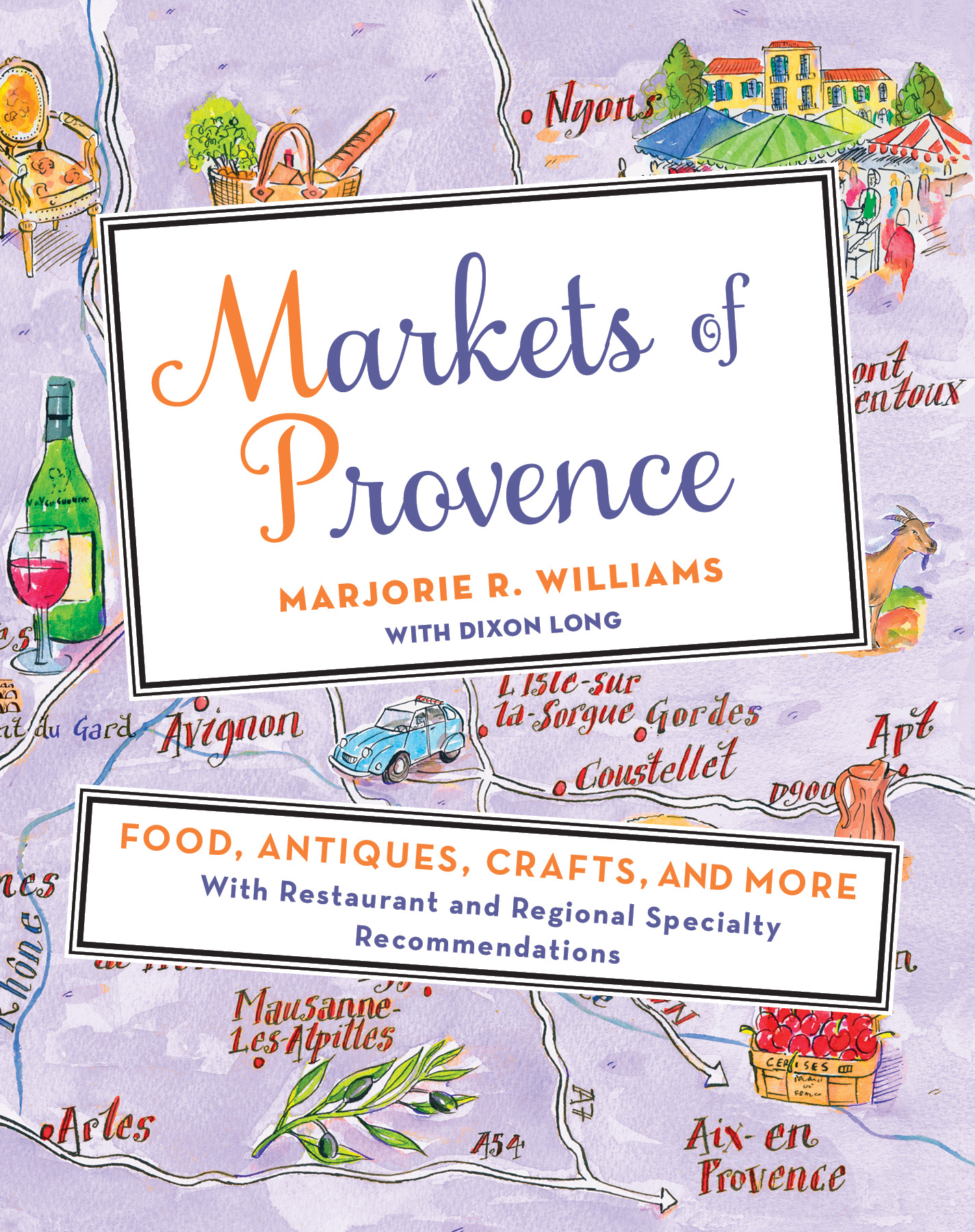scroll down for these recipes:
Moules Dijonnaise, and frites
Mussels with Saffron, Vermouth, and Harissa, and sweet frites
Moules au Pistou, and grilled garlic peasant bread
My first encounter with those baffling little mussels left me bewitched, bothered, and bewildered. When I was a child, I would gaze horrified as the steaming obsidian pile would be plucked, prodded, and consumed, growing into an equally obsidian if somewhat less steaming pile of shells in an identical bowl sitting across the table from me and in front of a relative as plump and warm as the shellfish themselves. But as sure as we all grow into adults who gain utility bills and inherit crystal champagne flutes, so too do we shed childhood prejudices and inherit our families’ gastronomic sensibilities. At the risk of appearing too hypocritical to my younger and more convictional self, I have changed my mind about the little dark darlings. As a mussel addict, and a young lady, I must admit I find them both as intimidating and mesmerizing as their homonym. I eat mussels in vast portions, and always relish an evening spent besotted by my briny pals. Luckily, however, you don’t need steroids to accomplish the perfect set of mussels.
I am shining the spotlight this week on the mussel because on my recent trip to New York, I walked by my very favorite mussel outpost: La Tour, formerly of Third Avenue and the upper Seventies. There, for something like $18.50, you could get all the moules and frites you could eat, à volonté, in any combination of three traditional sauces: marinière (white wine, garlic, onion, and parsley), provençal (tomato, wine, garlic, and basil), or my personal predilection, à la moutarde (mustard and wine). I have spent many a long and friendly evening perched on one of La Tour’s Parisian banquets drowning in steaming mustard sauce and cool, citrine Sancerre. It was closed!
But necessity is the mother of invention, as I’ve said before, and if La Tour cannot provide, then I must create. In this edition of French Revolution, you’ll find three different ways to prepare mussels, and some little accompaniments for the black pearls. Interestingly, the idea for French Revolution came to me at a mussels restaurant on the beach in Normandy. French food, to me, had always been one of those dichotomies that coexist sensibly only in the minds of far-Eastern contemplatives. On the one hand, it was the Madison Avenue bistro, with five forks of various sizes, uses, and timeliness, straight-backed chairs, waiters who dressed even more expensively than I did, and a menu accessible to me only because I was the daughter of a Parisian mother. On the other hand, I had my Parisian mother to thank for my first impression of French food: casual, traditional, elegant, whimsical, and, surtout, delicious. She would roast duck à l’orange and fry fresh frites that we would then eat with our hands in bed watching old black and white sitcoms. Which of the two was “la vraie cuisine française”?
In Normandy, the origin of the moule-frite fiesta, I was served my large pile of onyx mussels in an equally large and equally onyx cast iron kettle over a lively, waltzing votive flame. Around me was arranged my frites, my salade verte, my baguette, and a smattering of friends, family, and beer—all necessary at such an event. But one thing was missing: my seafood fork. I asked my mother if she had one. No. We both looked around. To me, French food had always been something to eat not with petite cutlery, mais avec les mains! And all around me, there were French people proving my point. Instead of a seafood fork to pluck the little diamonds from the rough, the Normans were using an attached set of shells as pincers. A large half-shell replaced a soup spoon as the utensil for lapping up all the mussels’ delicious winey liquor. Through the shells the Normans plunged, vite, vite, vite, all you can eat. French food can mean gossamer cages of sugar and mother of pearl caviar spoons, but je préfère manger avec les mains!
Mussels make the perfect meal for many reasons. They are cheap, often costing as little as $3 per pound. They are a one-pot wonder. They are cooked to perfection in under ten minutes—including prep time. The French often use them not only as a staple of their own cuisine, but as a canvas on which to demonstrate French technique with exotic flavors like curry or, here, saffron and harissa. They can be eaten delicately and politely with that infamous seafood fork, or eaten greedily with the shells themselves. They are elegant and classic while being simultaneously casual and welcoming. I challenge you to suggest another food so versatile or simple or impressive…or cheap! I think there is nothing better than serving mussels at a formal gathering—there is nothing better to break the ice then passing around the steaming bowl or calling for more bread or frites. Plus, a good working knowledge of mussels will always leave you looking cultured…
Here, I offer three very quick and easy and flavorful renditions of the traditional mussels “stew.” The first is my La Tour favorite, moules à la moutarde, made with two kinds of mustard, white wine, and thyme, and served with matchstick French fries and baguette. I also like to leave a pot of Dijon on the table to dip the bread and frites in. The dish is tangy and creamy and classic. Next is an exotic departure to Morocco, the former protectorate of France that had such an influence on its cuisine. This recipe uses saffron and the red-hot Moroccan red pepper relish harissa, and I like to serve it with something slightly and delightfully different: sweet frites. The last recipe is moules au pistou, or Mussels with Pesto, which is by far the quickest and easiest mussel recipe and is perfect for a summer day. All it requires is mussels, wine, and fresh bought pesto sauce. I like to serve it with garlicky grilled peasant bread.
Some notes to keep in mind when making mussels: When cleaning, de-beard and rinse. Also, a good way to make the mussels spit out any sand they might be ruminating is to soak them in a large bowl of cold water with a tablespoon of flour. Remember, leave sand in an oyster and get a pearl. Leave sand in a mussel and lose a tooth! To be honest, I often disregard both precautions. I generally use 3 pounds of mussels to feed 4 people.
But this rule you cannot disregard: before the mussels are cooked, discard any that are open. After the mussels are cooked, discard any that are closed.
With these recipes, you’ll have no excuse to wrinkle your nose at the little beasts or be as bothered or bewildered as I was. Now get in that kitchen and show off those mussels!
Moules Dijonnaise
3 pounds of mussels
1-2 tablespoons of olive oil
½ onion, thinly sliced
1 clove of garlic, minced
2 tablespoons of Dijon mustard
1 tablespoon of whole grain mustard
1 cup of dry white wine 2 sprigs of thyme
2 tablespoons of chopped fresh parsley (optional)
Salt and pepper
- Heat the olive oil in a wide, deep, heavy-bottomed pan over medium heat.
- Add the onion, and then the garlic, and a pinch of salt. Sauté until they are translucent and fragrant—just a couple of minutes.
- Whisk in the wine and mustards, along with the thyme, which you can leave right on the stems, as long as you remember to fish them out later. Season with a bit more salt and a good bit of freshly cracked black pepper.
- Add the mussels, and cover, allowing them to steam open. After 4-6 minutes, they should all have opened. Toss in the verdant shower of parsley, and serve immediately with fresh frites (see below) and hunks of torn warm baguette.
To serve à côté: Frites
2 Idaho potatoes, cut into thick matchsticks
Olive oil and vegetable oil for frying
Course salt
- Usually due to necessity, but also for flavor and high cooking temperature, I often mix my oils, using 2 parts vegetable oil to one part olive oil. Fill a large heavy-bottomed pan no more than half way up with this combination of oils, and heat the oil on medium heat until it has reached 350 degrees.
- Send in a test pilot: drop in a fry that you will want to snack on to see if the oil is at the correct temperature. If it sinks to the bottom, the oil is too cold. If it fizzles up immediately, the oil is too hot. It should sink and then rise gently, buoyed up by little bubbles of frying oil.
- Add the potato matchsticks in batches. You have a choice here: fry once for a great French fry, fry twice for the perfect frite. Between batches, or between first (the blanching stage) and second fries, remove the potatoes to a cooling rack or several layers of paper towel or both.
- Dust the hot fries with a wise pinch of salt.
Mussels with Saffron, Vermouth, and Harissa
3 pounds of mussels
¾ cup of dry white wine
¼ cup of dry vermouth
Pinch of saffron
2 shallots, sliced
1 tablespoon of olive oil
1 tablespoon of harissa
- Heat the olive oil over medium heat in a large, wide, heavy-bottomed pan.
- Sauté the shallot for less than 1 minute until fragrant.
- Pour off the vermouth into a separate glass, take the pan off the heat, and add in the liquor. Return the pan to the heat, and add the wine.
- Add in the saffron and the harissa—most harissa is fairly salty so taste before adding extra salt. Let these two bloom in the sauce for 30 seconds.
- Add in the mussels and cover, just long enough for the mussels to open—less than five minutes. Serve immediately with sweet potato fries (see below).
To serve à côté: Sweet Frites
2 medium sweet potatoes, cut into thick matchsticks
Vegetable oil and olive oil for frying
Course salt
Follow the same steps as if you were making plain frites (see above), but use the sweet potato instead.
Ingredients
- 3 pounds of mussels
- ½ cup of dry white wine
- 3 tablespoons of prepared fresh pesto sauce
Procedure
- Add the pesto and wine to a large, deep pan. Heat them over medium heat until they begin to simmer.
- Add the mussels and cover until they have steamed open—about five minutes.
- A great way to make this dish more luxurious would be to add just a hint of cream, or, instead, add a selection of halved colorful summer tiny tomatoes (they look like heirloom cherries) to a tablespoon of hot oil before adding the wine and pesto to the pan. Their skin will crackle, and they will erupt a bit, mingling their sweetness and sun-burst texture with the sauce.
Grilled Garlic Peasant Bread Ingredients
- ½ round of peasant bread
- Olive oil for drizzling 2-4 cloves garlic, peeled and halved
- Course salt
Grilled Garlic Peasant Bread Procedure
- Preheat a grill pan over medium heat.
- Cut the bread into thick slices, and then cut them in half again.
- Char the bread lightly on the grill, 2-3 minutes per side.
- Rub the hot bread with the cut end of a garlic clove. The garlic will melt into the bread…move onto the next clove as it dissolves away.
- Finish the grilled garlic bread with a light drizzling of golden olive oil and a sprinkling of course salt.










http://www.flexmussels.com
What a great site! Excellent advice for the perfect frite…and some inventive ways to sauce up those mussels.
Also, all the recipes at flexmussels.com/flavours illustrate just how much the mussel is the perfect canvas for worldwide flavors…maybe we should all eat these little peacemakers and see what we have in common! The Mexican looks like cerveza divinity, and in the French vein, the tarragon from the Parisienne would match perfectly with seafood.
On another note…looks like I wasn’t the first to think up this food pun!
Hi Kerry,
my girlfriend tried your mussel recipe last night.
Quel Delice !!! We really enjoyed the little mussels
the frites, and your website.
Keep it up, and looking forward to next week’s recipes
Alain